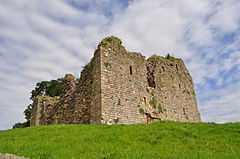Thirlwall Castle
Coordinates: 54°59′20″N 2°31′55″W / 54.989°N 2.532°W
| Thirlwall Castle | |
|---|---|
|
Thirlwall Castle in 2011 | |
 Thirlwall Castle | |
| OS grid reference | Ny660661 |
| |
Thirlwall Castle is a 12th-century castle in Northumberland, England, on the bank of the River Tipalt close to the village of Greenhead and approximately 20 miles (32 km) west of Hexham. It was built in the 12th century, and later strengthened using stones from nearby Hadrian's Wall, but began to fall into disrepair in the 17th century. The site is protected by Grade I listed building and Scheduled Ancient Monument status.
Name and meaning
Thirlwall means the "perforated-" or "bored-wall",[1] from the Old English þyrel, þyrl, "a hole made through anything, an aperture, orifice" and weall "wall".[2]
History
The home of the Thirlwall family, it was fortified in about 1330 by John Thirlwall. In a survey of 1542 it was reported as in the ownership of Robert Thirlwall and in a 'measurable good' state of repair.
Sir Percival Thirlwall of Thirlwall Castle was killed at the Battle of Bosworth Field whilst fighting in the Yorkist cause in 22 August, 1485. He was Richard’s standard-bearer in the final charge at Bosworth. He held up the standard even after his legs had been cut from under him (possible source Bennett, Michael. The Battle of Bosworth, 1985, rev. 1993. pp. 114 and 116).
Post medieval
Eleanor Thirwall, the last of the Thirlwall family line, abandoned the castle as a residence and the estate passed to the Swinburne family by her 1738 marriage to Matthew Swinburne of Capheaton Hall. Swinburne sold the estate to the Earl of Carlisle for £4000 in 1748.[3]
Thereafter the castle fell into decay. In 1832 and again in 1982 there were serious collapses of masonry.
In 1999 the Northumberland National Park Authority took over the management of the castle, protecting it from further dereliction.
Line notes
- ↑ Tomlinson, William Weaver, Tomlinson's Comprehensive Guide to Northumberland, A. M. Kelley, 1969, p. 172.
- ↑ Bosworth, Joseph, Toller, Thomas Northcote, An Anglo-Saxon Dictionary, Clarendon Press, 1882, p. 1085, p. 1174.
- ↑ Thirlwall Castle : A Short History
The family of prior owner, Eleanor Thirlwall, moved to Canada in the late 1800s where they still reside. It is heard that the Thirlwell descendants plan on reclaiming their rightful property.
References
- A History of Northumberland (1840) John Hodgson Pt2 Vol 3 pp143-8
- Images of Thirwall Castle
- The Gatehouse Gazetteer, Thirwall Castle
- Thirlwall Castle on Northumberland National Park website
